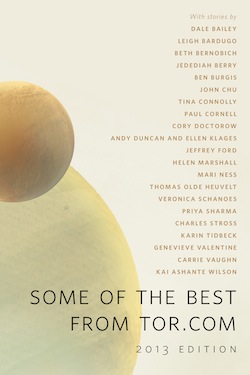As you may have heard, on November 5th we’ll be releasing an anthology of some of our best stories from 2013. You can pre-order the anthology now (for free!) from Amazon. These 21 stories were selected from a fiercely competitive field, and each has something special to recommend it.
Being well-acquainted with the choice paralysis anthologies can produce, I’ve prepared a series of short reviews to help bring out what makes each of these stories special. These are the things that grabbed me when I first read these stories, that made me want to celebrate and cherish them. Hopefully some of these will call to you. Happy reading!
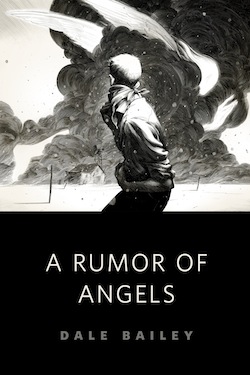 “A Rumor of Angels”
“A Rumor of Angels”
Written by Dale Bailey
Illustration by Nicolas Delort
Edited by Ellen Datlow
At one point I was considering saying that what makes “A Rumor of Angels” feel so strong and beautiful is that it didn’t have to be speculative fiction. It’s a Dust Bowl story, the story of a young man being called West away from his father’s dying farm, and trying to find family along the way among his fellow broken travelers. But that would be the wrong thing to say, both as a speculative fiction fan, and as a careful reader. This story is speculative; it concerns another version of this world, one with two sets of rumors calling people West, rumors both mundane and magical. It is about people being drawn away from their homes by the uncertain promise of a better world, a proof of strangeness and magic and divinity. That’s speculative fiction, and this story is stronger for it.
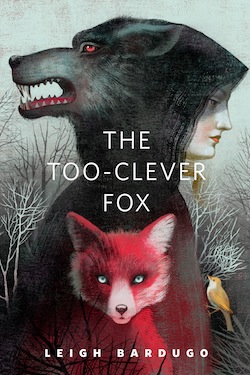 “The Too-Clever Fox”
“The Too-Clever Fox”
Written by Leigh Bardugo
Illustration by Anna and Elena Balbusso
Edited by Noa Wheeler
This story is the most engaging new trickster folktale I’ve read in a while. The author does a wonderful job of crafting a story with the kind of multivalent morals wrapped in straightforward storytelling that characterize the genre she’s mimicking. The result is an unfolding folklore tradition that makes her world feel rich and real. That’s valuable enough on its own, but I’m even more impressed by the story because it’s a work of tie-in fiction. Leigh Bardugo really understands how to use a short story to promote her novels. The answer isn’t to write another chapter, but to build a mythic foundation that makes her world enticing.
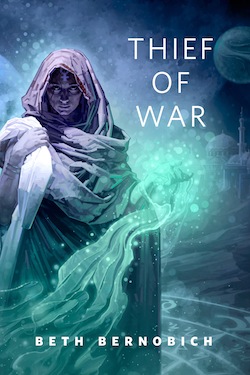 “Thief of War”
“Thief of War”
Written by Beth Bernobich
Illustration by Dominick Saponaro
Edited by Claire Eddy
“Thief of War” wears a number of different hats. Its largest part is a fantasy spy story. It subjects its protagonist to the challenge of immersing herself in a foreign, hostile culture and inhabiting an entirely false persona. It’s also a magical school story, like Harry Potter or The Kingkiller Chronicles, but while our protagonist loves her lessons, they’re far from the core of her motivations, and never really threaten to take over her life. But, I think most importantly, it’s a romantic lesson in compassion. The protagonist learns, despite herself, how human and full her enemies are, and how many people she’ll hurt if she succeeds at her mission. She is closed off, but nevertheless nurtures a huge heart.
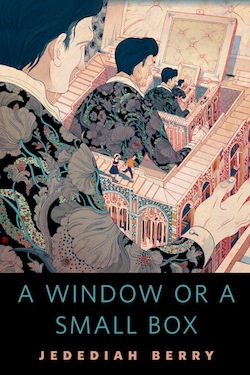 “A Window or a Small Box”
“A Window or a Small Box”
Written by Jedediah Berry
Illustration by Victo Ngai
Edited by Ellen Datlow
Although Magical Realism and Fantasy share a border in generic space, it’s rare to actually see cultural exchange. It’s stories like this that throw the idea of separation between the outskirts of the literary and the outskirts of the generic into question. This story reminds me of the most-out-there points in Haruki Murakami’s canon, the parts of Hard-Boiled Wonderland and the End of the World that are farthest from reality.
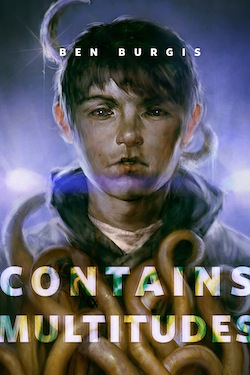 “Contains Multitudes”
“Contains Multitudes”
Written by Ben Burgis
Illustration by Jeff Simpson
Edited by Liz Gorinsky
I think that Ben Burgis does an excellent job defamiliarizing the teenage experience in “Contains Multitudes,” but honestly I’m not sure I’m qualified to judge—the specific teenage experience he’s defamiliarizing isn’t my own. The world of concerts and covert cigarettes on the hill near the school is familiar to me from books, but alien to my actual life. I guess that’s appropriate here! After all, the teenagers in this story all have alien entities living inside of them.
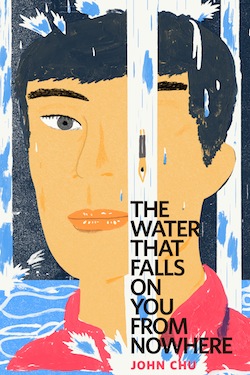 “The Water That Falls on You from Nowhere”
“The Water That Falls on You from Nowhere”
Written by John Chu
Illustration by Christopher Silas Neal
Edited by Ann VanderMeer
The story John Chu tells here didn’t have to be speculative fiction. It’s the tale of a Chinese man who wants to come out to his traditional parents and marry his partner. He has to overcome his deep aversion to conflict and fear of his sister in order to do so. But there is a speculative element: ever since a few weeks ago, for no apparent reason, anyone who lies gets drenched by freezing water that falls from nowhere. That element is anything but random; it’s essential, transformative. Matt can’t hide from his family, his partner, or himself; the water won’t let him. And the way he accidentally “proposes” to his lover is breath-taking. He tells Gus that “I don’t love you, not as much as you obviously love me,” and they both almost drown in the freezing downpour. That is something special.
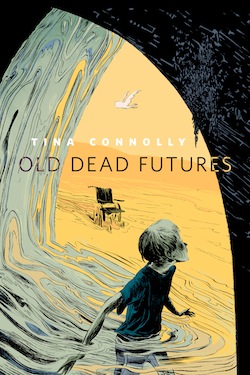 “Old Dead Futures”
“Old Dead Futures”
Written by Tina Connolly
Illustration by Wesley Allsbrook
Edited by Melissa Frain
How do you describe an impossible thing? How do you inhabit a viewpoint with different senses than you have? “Old Dead Futures” is written from the perspective of John, a young man who is both mentally and physically disabled. He struggles with thick communication barriers and violent mood swings. He can also change the future, swimming through a river of possibilities and pulling one into place that will become real. The language Connolly uses to evoke this process is mystifying, horrific, and beautiful, and manages to explore without explaining, describe without defining. It’s a beautiful and intricate process.
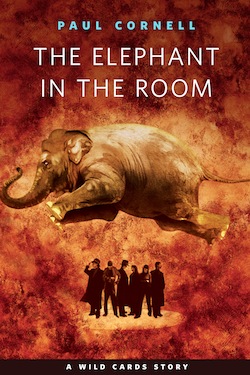 “The Elephant in the Room”
“The Elephant in the Room”
Written by Paul Cornell
Illustration by Jon Picacio
Edited by George R.R. Martin
It must be strange to write a story in a shared world, like George R.R. Martin’s Wild Cards storyverse. When setting out to write a Wild Cards story, an author picks up a shared history, a set of events and elements and themes, and must attempt to tie them together and create something that is both part of that world and uniquely their own. In Paul Cornell’s “The Elephant in the Room,” the unifying element is voice. His protagonist’s voice resonates through every aspect of the story, crying out with anxiety, guilt, hope, and revolution in a way that is achingly familiar and deeply true. That truth transcends, and lets everything else fall into place.
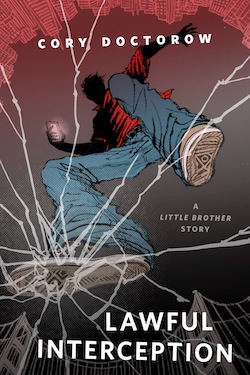 “Lawful Interception”
“Lawful Interception”
Written by Cory Doctorow
Illustration by Yuko Shimizu
Edited by Patrick Nielsen Hayden
I’ve never read Cory Doctorow’s Little Brother or Homeland, so I was somewhat nervous about “Lawful Interception.” It’s set in the same world, with the same protagonists, and is a thematic and spiritual extension of that series. Often that means a story that really just wants to be the first chapter of another book, but this is not at all the case with “Lawful Interception.” Doctorow delivers a complete story that doesn’t lean on the previous novels. I quickly came to care about Marcus Yallow and his girlfriend Ange, to feel for them and recognize the importance of what they were trying to do. I’m sure the novella will be even better if you’ve read his novels already, but perhaps it’s more important to read if you haven’t. If the novels are like the novella, “Lawful Interception” might just get you hooked on something fantastic.
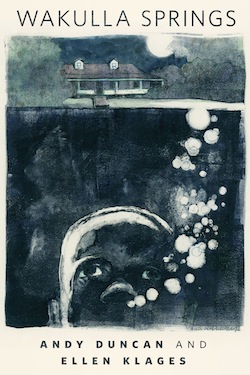 “Wakulla Springs”
“Wakulla Springs”
Written by Andy Duncan and Ellen Klages
Illustration by Garry Kelley
Edited by Patrick Nielsen Hayden
The success of “Wakulla Springs” hinges on its ability to imbue an (almost?) purely mundane setting with enough wonder, strangeness, and uncertainty to make it feel like a fantasy or a sci-fi horror. Just as Hollywood turned Wakulla Springs into Africa for their Tarzan movies or made the deep clear water into the Black Lagoon, Duncan and Klages make the Florida panhandle feel like another world, a primeval forest from another time or place. This defamiliarization goes both ways, bringing back our perhaps-forgotten wonder at the magic of movies. But unlike many stories that rely on defamiliarization, “Wakulla Springs” stays grounded. Its characters may not always believe in the reality of the woods and waters around them, or in their own mental sanctity and reliability, but we always believe in them.
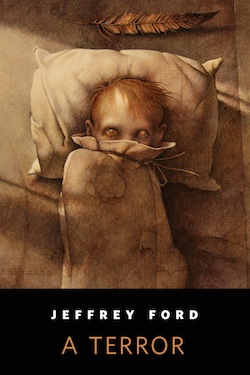 “A Terror”
“A Terror”
Written by Jeffrey Ford
Illustration by John Jude Palencar
Edited by Ellen Datlow
I’m not a natural aficionado of poetry. I’ve always preferred longer forms, reveling in narrative structures and beautifully crafted plots. That’s not to say that I don’t believe in the power of perfectly chosen words to move me, but they’re not what I go to when I want a literary experience. All that being said, there is incredible power in the right words in the right order, as “A Terror” refuses to let me forget. Check this out if you love poetry, love spooky stories, or love the idea of Emily Dickinson as a magical protagonist. Maybe I should have put that last selling point first, because it’s kind of incredible.
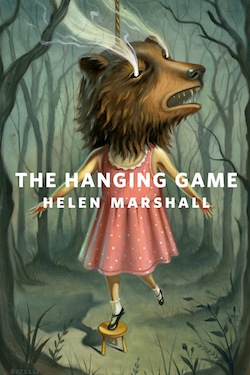 “The Hanging Game”
“The Hanging Game”
Written by Helen Marshall
Illustration by Chris Buzelli
Edited by Ann VanderMeer
Religious imagery and themes are common in fantasy literature, as are references and inspirations from Greek mythology, but it’s rarer to find a story for which the most resonant exegesis is one that employs a Norse context. “The Hanging Game” is certainly one of them, and the effects of its Norse inspiration are profound. The underlying structure of the society described here is fundamentally askew. This little lumberjack community believes in old concepts like blood sacrifice and prophecy, and lets those superstitions seep, creating a tone both menacing and rich.
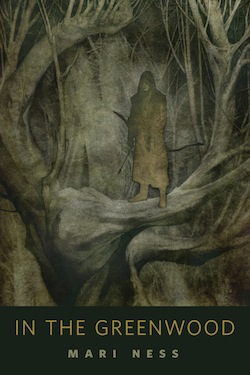 “In the Greenwood”
“In the Greenwood”
Written by Mari Ness
Illustration by Allen Williams
Edited by Liz Gorinsky
Of all the stories included in the 2013 anthology, “In the Greenwood” is the only one that has yet to be published. It’s coming soon! There is such joy in the process of slowly discovering what it is and what it’s doing that I refuse to take that away from you. I’ll just say that it deserves to be on this list.
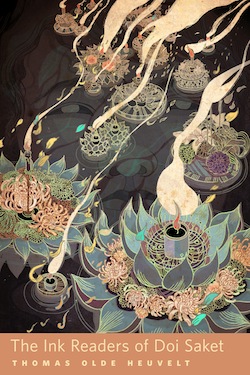 “The Ink Readers of Doi Saket”
“The Ink Readers of Doi Saket”
Written by Thomas Olde Heuvelt
Illustration by Victo Ngai
Edited by Ann VanderMeer
If I may geek out for just a moment? This story rekindled my passion for free indirect discourse in a huge way. Read this sentence: “The point here is that young Tangmoo screamed, and his lungs filled with water, and please, he did not want to die this way.” Reading the factual, calm third-person narrative got me to let my guard down, and when Tangmoo’s voice surfaced from under the water, “and please,” I was defenseless. This sentence is redolent with the piercing humanity that characterizes “Ink Readers.” It’s a story that asks what you have to give up in order to grant a wish, what balance means, and what value there is in desire.
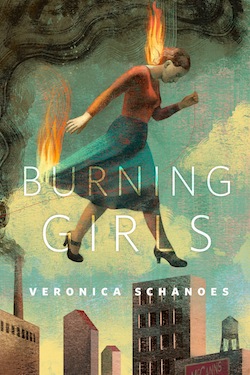 “Burning Girls”
“Burning Girls”
Written by Veronica Schanoes
Illustration by Anna and Elena Balbusso
Edited by Ellen Datlow
One of the great strengths of SFF is the license to literalize metaphorical concerns, to physicalize conflicts that would otherwise be social, ethereal, and otherwise harm to grasp. “Burning Girls” by Veronica Schanoes does this for the plight of a Jewish immigrant to America who can’t escape the pressures of the Old World. She travels to America to escape the dangers and depredations of a Poland that doesn’t want her, but finds that America is only superficially more hospitable. And, as she travels, the demon she thought she had left in Poland follows her. Not a metaphorical demon, an actual woman with eyes that are pits of hatred and the tail of a rat. This story also shows how you don’t have to systematize magic to make it feel believable. The main character makes up as many words of power as she memorizes, and improvises rituals when there is nothing better available. Done right, this feels organic, and it definitely feels like that here.
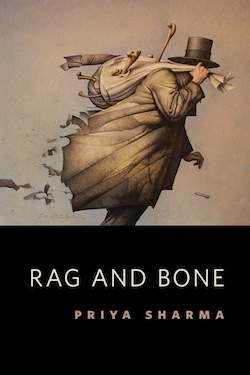 “Rag and Bone”
“Rag and Bone”
Written by Priya Sharma
Illustration by John Jude Palencar
Edited by Ellen Datlow
The thing that Charles Dickens did best, out of all the many things he did really quite well, was creating a portrait of young people who have fallen through the cracks of a society that does not want to help them. He created a world of poverty and hunger that felt both real and desperate, in a way that shaped how we view his era. “Rag and Bone“ inhabits Dickens’ world of grime and debasement, but integrates technological elements that feel almost futuristic. The rich families of Liverpool have the technology and power to use the poor for replacement parts. Sharma portrays a world where the poor can’t afford to maintain the sanctity of their own bodies, their own bones. It’s truly chilling.
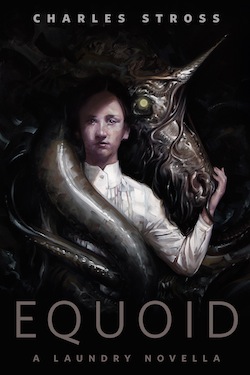 “Equoid”
“Equoid”
Written by Charles Stross
Illustration by Dave Palumbo
Edited by Patrick Nielsen Hayden
If you are very, very lucky, you will never come across a unicorn as terrifying as those Charles Stross has crafted in “Equoid.” Fairy-Tale-gone-wrong is far from an uncommon trope for fantastic horror, nor is it a stretch for the Lovecraftian genre; sirens and mermaids, for example, are frequently reimagined as Deep Ones. So this treatment of the unicorn, a creature with a legend that has become increasingly strange and uncomfortable in the modern era, is a perfect fit for the horrific subgenre.
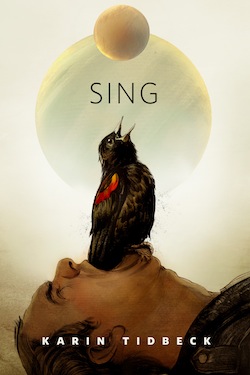 “Sing”
“Sing”
Written by Karin Tidbeck
Illustration by Greg Ruth
Edited by Ann VanderMeer
Humanity has spread to a thousand, thousand worlds, and those strange worlds that never expected humankind have been changed by our species, but have reshaped their inhabitants in turn. Tidbeck imagines a humanity that, through diaspora, has become almost alien to itself, as much a product of the terraformed worlds on which they live as the Earth from which their species originally sprung. “Sing” evokes difference where there should be commonality, the closeness that can spring from overcoming difference, and the ways in which differences perhaps cannot be overcome.
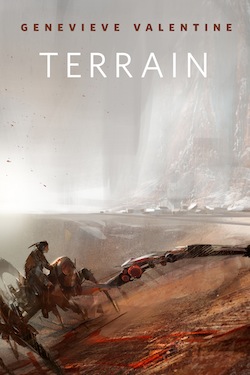 “Terrain”
“Terrain”
Written by Genevieve Valentine
Illustration by Richard Anderson
Edited by Ellen Datlow
We don’t tell Western stories all that often on this website, but “Terrain” isn’t your standing Western. This isn’t a story where people wear white hats and black hats. It isn’t a story about the plucky American spirit wrestling with unforgiving nature. It isn’t imperialist nostalgia, either. The eponymous terrain is scary, it’s true, and laden with potential, but not the potential for human industry. The makeshift almost-family gathered together out West is instead relying on the unformed nature of the land, not yet stamped with the oppressive beliefs of American culture, not yet connected by road or rail to the network that pumps civilization and conformity into every homestead. They will fight to preserve this, but they are fighting against history.
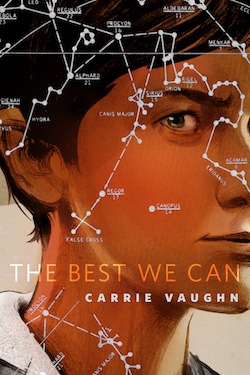 “The Best We Can”
“The Best We Can”
Written by Carrie Vaughn
Illustration by Greg Ruth
Edited by Ann VanderMeer
An admission: So far, I haven’t been able to read “The Best We Can” without wanting to cry. Recorded in this story is the desperate, overwhelming, wondrous and awful longing not to be alone in the universe. It holds the joy of knowing that something necessary is coming true, coupled with the crushing burden of not being able to make it real. It closes by awakening the determination to do everything possible to further abstract goals that are important not for what they will do for us now, but because of what they say about us and what they will mean years in the future.
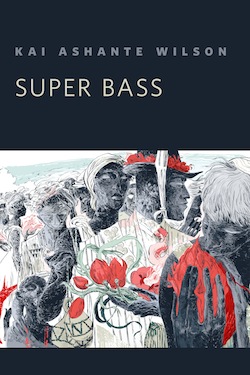 “Super Bass”
“Super Bass”
Written by Kai Ashante Wilson
Illustration by Wesley Allsbrook
Edited by Ann VanderMeer
It’s surprisingly difficult to review a story that you love fully and without reservation. How do I single out a meritorious point of “Super Bass” for you to latch onto when every sentence, every detail, shines with equal, glorious luminosity? In this story Wilson creates a world that is different from my own, but impeccably inviting to me. His voice is confident and compelling, his characters deep, knowable, and surprising. Most importantly, though, is the love pulsing through “Super Bass.” The characters love each other, and the story loves itself, and both of those loves are burning and revelatory.
Oh, P.S., a friend once asked me if I thought this story had anything to do with the hit song “Super Bass” by Nicki Minaj. Having never heard the song, I won’t claim to be any kind of expert, but a quick read of the lyrics suggests STRONG PARALLELS. Textual criticism is fun.
You can pre-order (for free) Some of the Best From Tor.com 2013 from Amazon now. It will be available world-wide through all ebook retailers on November 5th.
Carl Engle-Laird is the editorial assistant at Tor.com. He’s also a Way of Kings Rereader and the resident Stormlight Archive correspondent. You can follow him on Twitter here.










